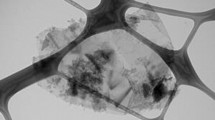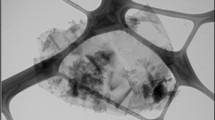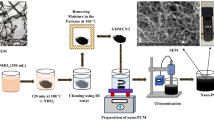Abstract
The present work aims to investigate the effects of various additives on the stability of graphene nanoplatelet (GnP)–based nanofluid phase change material (NFPCM) for cold thermal energy storage (CTES). The NFPCMs are prepared by dispersing six different types of surfactants (anionic, cationic, and non-ionic types) in deionized (DI) water at a mass ratio of 1:0.5 GnP to surfactant. NFPCMs can be found to be stable with a suitable surfactant even after 30 days using zeta-potential distribution, UV–vis absorption, visual inspection, and sedimentation tests at low temperature. The maximum enhancement in thermal conductivity of 8.3% and 48.3% is recorded in both liquid and solid states for the NFPCM with gum arabic (GA) respectively. The viscosity was enhanced by the dispersion of non-ionic surfactants, where the anionic surfactant (sodium dodecylbenzene sulfonate (SDBS)) NFPCM had a 29.9% lower augmentation compared to DI water. Furthermore, differential scanning calorimetry (DSC) results demonstrate that the phase change properties of the NFPCM are significantly affected depending on the surfactant type. The maximum phase change enthalpy is lowered (10.6%) in the Tween 80 NFPCM as compared to the base PCM. The long-term stability with the highest thermal transport property of the NFPCM storage unit integrated with the chiller is capable of achieving environmental pollution remediation by minimising the time it takes to charge the PCM.
















Similar content being viewed by others
Data availability
The datasets used and analysed during the current study are available from the corresponding author on reasonable request.
Abbreviations
- h:
-
Heating
- c:
-
Cooling
- k:
-
Thermal conductivity
- S:
-
Uncertainty
- DI:
-
Deionized
- BF:
-
Base fluid
- NF:
-
Nano fluid
- SF:
-
Surfactant fluid
- GA:
-
Gum arabic
- TEM:
-
Transmission electron microscope
- DLS:
-
Dynamic light scattering
- ELS:
-
Electrophoretic light scattering
- PCM:
-
Phase change material
- HTF:
-
Heat transfer fluid
- CMC:
-
Critical micelle concentration
- DSC:
-
Differential scanning calorimetry
- CNT:
-
Carbon nanotubes
- GnP:
-
Graphene nanoplatelet
- SDS:
-
Sodium dodecyl sulphate
- PVP:
-
Polyvinylpyrrolidone
- SDBS:
-
Sodium dodecylbenzene sulfonate
- CTAB:
-
Cetyltrimethylammonium bromide
- CTES:
-
Cold thermal energy storage
- LHTES:
-
Latent heat thermal energy storage
- HRSEM:
-
High resolution scanning electron microscopy
- MWCNT:
-
Multi-wall carbon nanotubes
- NFPCM:
-
Nanofluid phase change material
- NEPCM:
-
Nano enhanced phase change material
References
Borode AO, Ahmed NA, Olubambi PA et al (2021) Effect of various surfactants on the viscosity, thermal and electrical conductivity of graphene nanoplatelets Nanofluid. Int J Thermophys 42:1–15. https://doi.org/10.1007/s10765-021-02914-w
Chandrasekaran P, Cheralathan M, Kumaresan V, Velraj R (2014) Enhanced heat transfer characteristics of water based copper oxide nanofluid PCM (phase change material) in a spherical capsule during solidification for energy efficient cool thermal storage system. Energy 72:636–642. https://doi.org/10.1016/j.energy.2014.05.089
Demirkır C, Erturk H (2020) Rheological and thermal characterization of graphene-water nanofluids: hysteresis phenomenon. Int J Heat Mass Transf 149:3–11. https://doi.org/10.1016/j.ijheatmasstransfer.2019.119113
Dhivagar R, Kannan KG (2022) Thermodynamic and economic analysis of heat pump-assisted solar still using paraffin wax as phase change material. Environ Sci Pollut Res 29:3131–3140. https://doi.org/10.1007/s11356-021-17183-1
Dhivagar R, Mohanraj M, Belyayev Y (2021a) Performance analysis of crushed gravel sand heat storage and biomass evaporator-assisted single slope solar still. Environ Sci Pollut Res 28:65610–65620. https://doi.org/10.1007/s11356-021-15487-w
Dhivagar R, Mohanraj M, Deepanraj B, Murugan VS (2021b) Assessment of single slope solar still using block and disc magnets via productivity, economic, and enviro-economic perspectives: a comparative study. Environ Sci Pollut Res. https://doi.org/10.1007/s11356-021-15565-z
Dhivagar R, Mohanraj M, Raj P, Gopidesi RK (2021c) Thermodynamic analysis of single slope solar still using graphite plates and block magnets at seasonal climatic conditions. Water Sci Technol 84:2635–2651. https://doi.org/10.2166/wst.2021.156
Fernandez-Merino MJ, Paredes JI, Villar-Rodil S et al (2012) Investigating the influence of surfactants on the stabilization of aqueous reduced graphene oxide dispersions and the characteristics of their composite films. Carbon N Y 50:3184–3194. https://doi.org/10.1016/j.carbon.2011.10.039
Ganesh Kumar P, Sakthivadivel D, Thangapandian N et al (2021) Effects of ultasonication and surfactant on the thermal and electrical conductivity of water – solar glycol mixture based Al2O3 nanofluids for solar-thermal applications. Sustainable Energy Technol Assess 47:101371. https://doi.org/10.1016/j.seta.2021.101371
Ganeshkumar P, Kumaresan V, Velraj R (2017) Stability, viscosity, thermal conductivity, and electrical conductivity enhancement of multi-walled carbon nanotube nanofluid using gum arabic. Fullerenes, Nanotubes, Carbon Nanostruct 25(4):230–240. https://doi.org/10.1080/1536383X.2017.1283615
Harish S, Orejon D, Takata Y, Kohno M (2017) Enhanced thermal conductivity of phase change nanocomposite in solid and liquid state with various carbon nano inclusions. Appl Therm Eng 114:1240–1246. https://doi.org/10.1016/j.applthermaleng.2016.10.109
Ilyas SU, Ridha S, Abdul Kareem FA (2020) Dispersion stability and surface tension of SDS-Stabilized saline nanofluids with graphene nanoplatelets. Colloids Surf A Physicochem Eng Asp 592:124584. https://doi.org/10.1016/j.colsurfa.2020.124584
Jia L, Peng L, Chen Y et al (2014) Improving the supercooling degree of titanium dioxide nanofluids with sodium dodecylsulfate. Appl Energy 124:248–255. https://doi.org/10.1016/j.apenergy.2014.03.019
Karimi MA, Mozaheb MA, Hatefi-Mehrjardi A et al (2015) A new simple method for determining the critical micelle concentration of surfactants using surface plasmon resonance of silver nanoparticles. J Anal Sci Technol 6:4–11. https://doi.org/10.1186/s40543-015-0077-y
Kazemi I, Sefid M, Afrand M (2020) A novel comparative experimental study on rheological behavior of mono & hybrid nanofluids concerned graphene and silica nano-powders: characterization, stability and viscosity measurements. Powder Technol 366:216–229. https://doi.org/10.1016/j.powtec.2020.02.010
Kim S, Tserengombo B, Choi SH et al (2018) Experimental investigation of dispersion characteristics and thermal conductivity of various surfactants on carbon based nanomaterial. Int Commun Heat Mass Transf 91:95–102. https://doi.org/10.1016/j.icheatmasstransfer.2017.12.011
Kim SC, Prabakaran R, Sakthivadivel D et al (2020) Thermal transport properties of carbon-assisted phase change nanocomposite. Fullerenes, Nanotubes, Carbon Nanostruct 28:925–933. https://doi.org/10.1080/1536383X.2020.1786814
Kumar PG, Kumaresan V, Velraj R (2016) Experimental investigation on thermophysical properties of solar glycol dispersed with multi-walled carbon nanotubes. Fullerenes, Nanotubes, Carbon Nanostruct 24:641–652. https://doi.org/10.1080/1536383X.2016.1219852
Kumaresan V, Raghavan KS, Ponrajan Vikram M, Iyyappan J (2021) Role of graphitized mesoporous carbon on solidification and melting characteristics of water for cool thermal storage. Fullerenes, Nanotubes, Carbon Nanostruct 29:890–898. https://doi.org/10.1080/1536383X.2021.1910811
Mingzheng Z, Guodong X, Jian L et al (2012) Analysis of factors influencing thermal conductivity and viscosity in different kinds of surfactant solutions. Exp Therm Fluid Sci 36:22–29. https://doi.org/10.1016/j.expthermflusci.2011.07.014
Moffat RJ (1988) Describing the uncertainties in experimental results. Exp Therm Fluid Sci 1:3–17. https://doi.org/10.1016/0894-1777(88)90043-X
Morimoto T, Kawana Y, Saegusa K, Kumano H (2019) Supercooling characteristics of phase change material particles within phase change emulsions. Int J Refrig 99:1–7. https://doi.org/10.1016/j.ijrefrig.2018.11.039
Murugan P, Ganesh Kumar P, Kumaresan V et al (2018) Thermal energy storage behaviour of nanoparticle enhanced PCM during freezing and melting. Phase Transitions 91:254–270. https://doi.org/10.1080/01411594.2017.1372760
Nazari B, Ranjbar Z, Hashjin RR, et al (2019) Dispersing graphene in aqueous media: investigating the effect of different surfactants. Colloids Surfaces A Physicochem Eng Asp 582. https://doi.org/10.1016/j.colsurfa.2019.123870
Prabakaran R, Sidney S, Lal DM, et al (2019) Solidification of graphene-assisted phase change nanocomposites inside a sphere for cold storage applications. Energies 12(18):3473. https://doi.org/10.3390/en12183473
Prabakaran R, Prasanna Naveen Kumar J, Mohan Lal D et al (2020) Constrained melting of graphene-based phase change nanocomposites inside a sphere. J Therm Anal Calorim 139:941–952. https://doi.org/10.1007/s10973-019-08458-4
Sarsam WS, Amiri A, Kazi SN, Badarudin A (2016) Stability and thermophysical properties of non-covalently functionalized graphene nanoplatelets nanofluids. Energy Convers Manag 116:101–111. https://doi.org/10.1016/j.enconman.2016.02.082
Sathishkumar A, Cheralathan M (2022a) Influence of thermal transport properties of NEPCM for cool thermal energy storage system. J Therm Anal Calorim 147:367–378. https://doi.org/10.1007/s10973-020-10339-0
Sathishkumar A, Cheralathan M (2022b) Effect of active multi-walled carbon nanotubes (MWCNT) on the energy storage density of DI water for cool thermal storage system. Environ Sci Pollut Res. https://doi.org/10.1007/s11356-022-18779-x
Sathishkumar A, Kumaresan V, Velraj R (2016) Solidification characteristics of water based graphene nanofluid PCM in a spherical capsule for cool thermal energy storage applications. Int J Refrig 66:73–83. https://doi.org/10.1016/j.ijrefrig.2016.01.014
Sidney S, Prabakaran R, Kim SC, Dhasan ML (2021) A novel solar-powered milk cooling refrigeration unit with cold thermal energy storage for rural application. Environ Sci Pollut Res 29(11):16346–16370. https://doi.org/10.1007/s11356-021-16852-5
Sundaram P, Kalaisselvane A (2021) Effect of different additives on freezing characteristics and stability of GnP-aqueous-based PCM for cold thermal storage. J Therm Anal Calorim. https://doi.org/10.1007/s10973-021-11056-y
Vikram MP, Kumaresan V, Christopher S, Velraj R (2019) Experimental studies on solidification and subcooling characteristics of water-based phase change material (PCM) in a spherical encapsulation for cool thermal energy storage applications. Int J Refrig 100:454–462. https://doi.org/10.1016/j.ijrefrig.2018.11.025
Wu W, Wang X, Xia M et al (2020) A novel composite PCM for seasonal thermal energy storage of solar water heating system. Renew Energy 161:457–469. https://doi.org/10.1016/j.renene.2020.06.147
Xian HW, Sidik NAC, Saidur R (2020) Impact of different surfactants and ultrasonication time on the stability and thermophysical properties of hybrid nanofluids. Int Commun Heat Mass Transf 110:104389. https://doi.org/10.1016/j.icheatmasstransfer.2019.104389
Xuan Y, Li Q, Tie P (2013) The effect of surfactants on heat transfer feature of nanofluids. Exp Therm Fluid Sci 46:259–262. https://doi.org/10.1016/j.expthermflusci.2012.12.004
Yang L, Villalobos U, Akhmetov B, et al (2021) A comprehensive review on sub-zero temperature cold thermal energy storage materials, technologies, and applications: state of the art and recent developments. Appl. Energy 288:116555. https://doi.org/10.1016/j.apenergy.2021.116555
Zahir MH, Mohamed SA, Saidur R, Al-Sulaiman FA (2019) Supercooling of phase-change materials and the techniques used to mitigate the phenomenon. Appl Energy 240:793–817. https://doi.org/10.1016/j.apenergy.2019.02.045
Acknowledgements
The authors wish to thank the Department of Mechanical Engineering, Puducherry Technological University (Erstwhile Pondicherry Engineering College), Puducherry, for the support and encouragement in carrying out this research work. The authors would also like to thank the Department of Mechanical Engineering, SRM Institute of Science and Technology, Kattankulathur, Chennai, for providing the facilities (DSC, TEMPOS, and UV-Vis spectrophotometer) to carry out the research work.
Author information
Authors and Affiliations
Contributions
Experimentation, formal analysis, writing—original draft preparation, P. Sundaram; writing—review and editing, P. Sundaram and A. Kalaisselvane; supervision, A. Kalaisselvane.
Corresponding author
Ethics declarations
Ethics approval
The authors attest that this paper has not been published elsewhere, the work has not been submitted simultaneously for publication elsewhere and the results presented in this work are true and not manipulated.
Consent to participate
All the individual participants involved in the study have received informed consent.
Consent for publication
The participants have consented to the submission of the study to the journal.
Conflict of interest
The authors declare no competing interests.
Additional information
Responsible Editor: George Z. Kyzas
Publisher's note
Springer Nature remains neutral with regard to jurisdictional claims in published maps and institutional affiliations.
Rights and permissions
About this article
Cite this article
Palanichamy, S., Athiimoulam, K. Influence of various additives on stability and phase change characteristics of DI water-GnP-based NFPCM for cold thermal energy storage systems. Environ Sci Pollut Res 29, 66935–66949 (2022). https://doi.org/10.1007/s11356-022-20419-3
Received:
Accepted:
Published:
Issue Date:
DOI: https://doi.org/10.1007/s11356-022-20419-3




